Piloting a heavily-armed Griffon helicopter over Afghanistan
By Gary Lewchuk
“The ability to prevent troops from being fired upon just by our presence, not even having to fire a round, is something to take pride in,” said Captain Jason Marchinko, who flew a heavily armed CH-146 Griffon helicopter for his second tour in Afghanistan during the summer.
“With the armament we had on the Griffon, the Griffons became feared by the insurgents,” the former Canora resident said. “When our ground troops requested our support, the insurgents would stop fighting and hide as soon as we arrived on station. They would actually wait for us to leave, and once we were out of sight they would engage our ground troops again.”
It was obvious that having armed helicopters above dismounted troops or vehicles moving through the AO (Area of Operations) proved to be an excellent deterrent and has undoubtedly saved soldiers lives, Marchinko said.
“There was a bit of anticipation, especially when we would radio the ground force as we transit to their location and you could hear gun fire and yelling coming through in the background of their transmissions. But every time we provided support, it ended up with us showing up and everything going quiet. It actually got quite frustrating because we knew there was a good chance that once we left, our ground troops would get engaged again.
Though flying over the operations area, Marchinko was not immune to witnessing the dangerous conditions facing the troops on the ground.
In one particular case, he recalled hearing about troops who were on a patrol, clearing some compounds. They were on foot and hit an improvised explosive (IED). “One American soldier lost his legs due to the blast, which really hit home how dangerous it was for the soldiers on the ground. Ground searches located caches of weapons, explosives, drugs and other items insurgents tried to hide for future use to support their cause. It validates why we were there and that something needed to be done to stop the insurgency.”
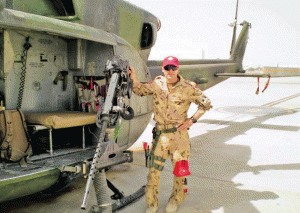
- Because the Canadian Griffon helicopters are heavily armed, the insurgents usually dispersed upon seeing the helicopters approach. Marchinko shows one of the heavy machine guns employed by the Griffin.
For this tour, Marchinko arrived in Afghanistan in March as part of the Canadian Helicopter Force (CHF), also known as Task Force Freedom. The CHF employs two types of helicopters: the Griffon and the much larger transport CH-147 Chinook
“My job was to provide armed escort to the Chinook in order to deter and respond to any insurgent attacks directed at the Chinooks. The Griffon is substantially armed and is employed in sections of two helicopters. The Chinooks, even though they are much bigger and used mostly for transport, are extremely quick and manoeuvrable, and also armed.
“However, because of its size, the Chinook presents a bigger target to insurgents, making it more vulnerable especially when transporting troops. By using the Griffons as an escort section, the Chinook is free to focus more on its job of sustainment of Forward Operating Bases (FOBs), moving troops to where they need to go, and the general safety of its load, while the Griffons focus is on the security of the Chinook and dealing with anything that pops up, giving the Chinook the time and space to evade attacks.”
Marchinko reiterated that the Griffons are also employed to provide armed over-watch of troops on the ground.
While the tours are usually about six months long, the work-up training for the rotation involves at least the same amount of special training, he said. Throughout his training for this rotation he was employed as a first officer on the Griffin, but just before deployment, he completed his upgrade to an aircraft captain (AC).
“Being an AC also entailed me to take the lead of the section (two Griffons) for a few missions, including both escorting the Chinook and flying area of operations watch for the ground force during its operations. So, this past tour was extremely busy for me and, in some cases, I had a very steep learning curve.”
Also, the Griffons participated in the larger objective called Operation Athena Roto 11 which was to provide helicopter assets in the overall effort of the Canadian Forces to help Afghans rebuild their country as a stable, democratic and self-sufficient society, Marchinko said.
“The Canadian Forces are integral to a whole-of-government approach that has military, diplomatic, development, and policing and corrections components.”
During his tour, Marchinko also participated in a drawn-out transition period because July 5 was the official date that Canada’s combat mission ended. During the handover process with the U.S. and the tear-down efforts of some Canadian tactical infrastructure, there were numerous “relief in place” missions which entailed the Griffons making trips to the forward operating bases (FOBs).
“All these trips required the movement of personnel and equipment to and amongst the FOBs, and bringing personnel and equipment back to Kandahar. However, we also supported Canadian combat logistics patrols which were convoys moving personnel and equipment through the area of operations, as well as Canadian/American combat operations during that transition period.”
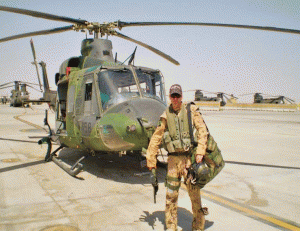
- Capt Jason Marchinko was photographed leaving his helicopter at the Kandahar Air Field during his recent tour in Afghanistan.
Marchinko noted that the area of operations appeared to be much quieter than during his previous tour, however he also noted that the area of operations looked a lot different two years ago. The first time, the Canadian AO was much larger and there were substantially less troops to patrol than on this tour.
He was unable to even guess the number of terrorist activities noted this time around, but from his perspective, there seemed to be fewer incidents this tour.
“What makes this interesting is that my last tour was during the winter and this tour was during the summer or fighting season.’ I do believe the country is in better shape than it was two years ago. More schools and roads have been built, and the number of ISAF troops has increased significantly
Aerial view of Afghan life
When the adrenalin was not pumping, Marchinko took the time to make observations of the sights not often seen by visitors to Afghanistan. He noted that the Afghanistan countryside is quite unique.
“Working out of Kandahar Air Field (KAF), we spent much time flying over the Registan Desert which has almost copper-coloured sand. There are several small, but steep mountain ranges throughout the area, sticking out of the ground like teeth. The land in between these ranges is mostly flat which really accentuates their characteristics.
“We spent most of our time flying over the rural areas so I didn’t see too many modern structures. Some do exist, but for the most part you see them in urban areas like Kandahar City. Most of the buildings we saw looked like they were made of mud or plaster, and we saw a few made of bricks. The rural areas had little villages that were joined via dirt/gravel roads, which normally had mud walls on one side, if not both.
“There were isolated fields of green where farmers grew their crops, which at times resembled islands in a sea of sand. The farmers are quite talented in the ways of irrigation. The lush crops they could grow in a desert environment were amazing. There were numerous grape fields with vines growing on six-foot berms, which stood out as an obvious landmark of the area. There were orchards, sunflower fields, wheat fields, and marijuana crops that we could see (and sometimes smell) and of course, the poppy fields that had bright pink flowers which bloomed just before they harvested the crops.
“Most of the time we flew low over the compounds and fields so we got to see, to some extent, what life was like behind the compound walls. There were children playing, food cooking outside in ovens or fire pits, and clothes drying on lines. In the nearby fields, kids would be helping their parents with herding sheep or goats, or helping them in the fields.
On the really hot days (mid to high 40s), we saw kids playing in the small rivers or creeks that ran beside some of the roads.
“At night, families would sleep outside on the flat roofs of their homes. It was kind of cool to see small herds of camels roaming the terrain and the numerous Bedouin camps sporadically located on the ground. Surprisingly, there were quite a few vehicles on the roads; motorcycles and mopeds were rampant in the country. I saw Highway 1 at night, which runs west to east through Kandahar City, and it reminded me of the Anthony-Henday in Edmonton due to the amount of traffic. Yet, it was nothing to see a tractor pulling a cart piled with hay, slowly creeping down the highway. People still use donkeys to haul numerous things, including people, from place to place. It was quite a different country than what we were used to here in Canada.
“Some of the mosques we saw were generally quite elaborate and well-kept. They definitely stood out amongst the other buildings and compounds.”
First tour
Marchinko’s first tour in Afghanistan was during the winter of 2008-09. For that tour, he was taken away from his flying duties and was part of the Tactical Air Control Party (TACP) which worked out of the Task Force Kandahar Provincial Operations Centre (TFK POC).
Because the Canadian Air Wing was not yet operational, a big part of his job entailed getting helicopter, and in some cases fixed-wing aircraft, support for the task force.
“All helicopter requests went through me, up the chain of command, and depending on priorities and aircraft available, they would decide where the aircraft should go. The job required a great deal of liaison with the units providing the aviation support.
“A secondary part of my job was being the Close Air Support (CAS) representative in the POC. Based on video feeds from Close Air Support (CAS) aircraft, I would keep the POC commander apprised of all ground target engagements. At times, I would help control CAS assets, to look for potential insurgent activity and evidence of IED placement. This was done by utilizing a video feed from the supporting aircrafts sensors and coordinating with the pilots.
He had a short leave during the first tour and when he returned “the Canadian Air Wing had officially stood up” so part of his job was taken over by those personnel.
“This allowed me to focus on aviation supporting deliberate operations and I got more involved with the CAS side of the house. This tour, although it took me away from flying for almost a year and a half, was incredibly educational and satisfying.”
“The hardest part of doing these tours is leaving my family, in particular the kids,” Marchinko said. “I found this tour much more difficult because of being away from the boys.”
During his first tour, he had hoped to be on leave when his second son was born. However, Lochlan arrived two weeks early, but he managed to spend his whole leave with his newly enlarged family.
During the first tour, it was especially difficult to be away from his older son Greyson, who was only two at the time. For his last tour, he was away as much as five months without seeing them. “Having two little kids at home, five months is a long time to be away and I missed them severely.”
What most people don’t realize is the time involved in pre-deployment training. During much of this training, he is also away from the family.
For his first tour, he spent two weeks in Petawawa, five weeks at Nellis AFB outside of Las Vegas, one week in Winnipeg,and four weeks in Wainwright. For the second tour, he was able to do more of the workup training at home, however, he did spend one week in Cold Lake, over two weeks in Yuma, Arizona; and two weeks in Wainwright.
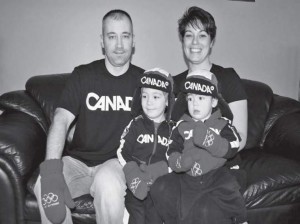
- Proud to serve his country, Jason Marchinko and his family love to show it with Canadian logos on their clothing. His wife is Tami and their sons are Greyson and Lochlan.
“Although not directly related to deployment training, I spent three weeks in Penticton, B.C. on a mountain flying course and one week of simulator training at CFB Gagetown, N.B. So, training away from home to prepare to deploy away from home, does add to the pressures of going on tour. Pre-workup training can be so exhausting that it almost becomes a relief to arrive in theatre.”
The Positive Side
“In my job alone, I have witnessed many positives of serving in Afghanistan. The service that I had a part in providing to the ground troops over the two tours has been substantial in my opinion.
Tactics were employed to hunt down insurgent placing IEDs and those tactics had a dramatic effect on reducing the number of IEDs struck by ground forces. “Obtaining aviation support for Canadian troops that directly protected them and got them off the roads and hence away from IEDs, is not something to be marginalized,” Marchinko said.
“Protecting troops and cargo as they are safely removed from the roads by being flown from FOB to FOB, earned us the respect and admiration of the troops we supported. That’s job satisfaction.”
Marchinko said he had also witnessed much being done for the people of Afghanistan. While in theatre he saw the Canadian Forces and the international community do many great things for the country. “We have had moral successes and prevented re-occurring atrocities.”

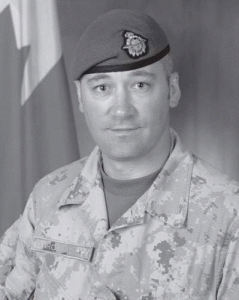
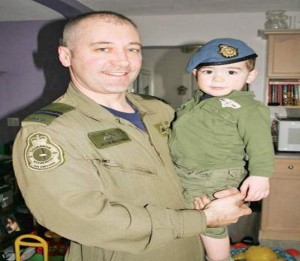
Thanks for this report – however.. what is “AC”? it’s not a rank, Captain Marchinko’s RANK is Captain.. He’s flying a Griffon not a Griffin!